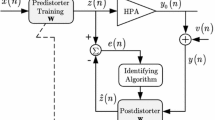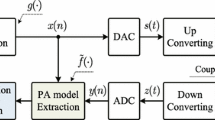Abstract
This paper proposes a new approach of digital predistortion (DPD) technique based on the adaptive indirect learning architecture (ILA) by using a recursive prediction error minimization (RPEM) algorithm for linearizing radio frequency (RF) power amplifiers (PAs) in emerging wideband communication systems. In the proposed RPEM-based linearization approach, the forgetting factor varies with time and is less sensitive to noise. Therefore, the predistorter (PD) parameter estimates become more consistent and accurate in steady state so that the mean square errors can be reduced. Both the error vector magnitude (EVM) and the adjacent channel power ratio (ACPR) are used to evaluate the DPD technique in RF PAs employing the proposed linearization. The efficiency validation of the proposed method is based on a simulated PA Wiener model. The simulation results have clarified the improvement of the proposed adaptive ILA-based DPD with RPEM algorithm in terms of both EVM and ACPR.














Similar content being viewed by others
References
Chen Y, Guo Z, Yang X et al (2018) Optimization of coverage in 5g self-organizing small cell networks. Mobile Networks and Applications 23(6)
Ahn J, Lee J, Park S et al (2019) Power efficient clustering scheme for 5g mobile edge computing environment. Mobile Netw Appl 24(2)
Ghannouchi FM, Hammi O (2009) Behavioral modeling and predistortion. IEEE Microw Mag 10(7):52–64
Chani-Cahuana J, Landin PN, Fager C, Eriksson T (2016) Iterative learning control for RF power amplifier linearization. IEEE Trans Microw Theory Tech 64(9):2778–2789
Guan L, Zhu A (2014) Green communications: digital predistortion for wideband RF power amplifiers. IEEE Microw Mag 15(7):84–99
Ding L, Zhou GT, Morgan DR, Ma Z, Kenney JS, Kim J, Giardina CR (2004) A robust digital baseband predistorter constructed using memory polynomials. IEEE Trans Commun 52(1):159– 165
Guo Y, Yu C, Zhu A (2015) Power adaptive digital predistortion for wideband RF power amplifiers with dynamic power transmission. IEEE Trans Microw Theory Tech 63(11):3595–3607
Schoukens M, Hammenecker J, Cooman A (2017) Obtaining the preinverse of a power amplifier using iterative learning control. IEEE Trans Microw Theory Tech 65(11):4266–4273
Zhou D, DeBrunner VE (2007) Novel adaptive nonlinear predistorters based on the direct learning algorithm. IEEE Trans Signal Process 55(1):120–133
Choi S, Jeong ER, Lee YH (2009) Adaptive predistortion with direct learning based on piecewise linear approximation of amplifier nonlinearity. IEEE Select Topics Signal Process 3(3):397–404
Suryasarman PM, Springer A (2015) A comparative analysis of adaptive digital predistortion algorithms for multiple antenna transmitters. IEEE Trans Circuits Syst I 62(5):1412–1420
Eun C, Powers EJ (1997) A new Volterra predistorter based on the indirect learning architecture. IEEE Trans Signal Process 45(1):223–227
Morgan DR, Ma Z, Ding L (2003) Reducing measurement noise effects in digital predistortion of RF power amplifiers. In: Proc IEEE International Conference on Communications (ICC’03), pp 2436–2439
Paaso H, Mammela A (2008) Comparison of direct learning and indirect learning predistortion architectures. In: Proc IEEE international symposium on wireless communication systems, pp 309–313
Hussein MA, Bohara VA, Venard O (2012) On the system level convergence of ILA and DLA for digital predistortion. In: Proc. 2012 international symposium on wireless communication systems (ISWCS), pp 870–874
Guan L, Zhu A (2011) Dual-loop model extraction for digital predistortion of wideband RF power amplifiers. IEEE Microwave and Wireless Components Letters 21(9):501–503
Mohr B, Li W, Heinen S (2012) Analysis of digital predistortion architectures for direct digital-to-RF transmitter systems. In: Proc. 2012 IEEE 55th international midwest symposium on circuits and systems (MWSCAS), pp 650–653
Söderström T, Stoica P (eds) (1989) System identification. Prentice-Hall Inc., Upper Saddle River
Abdelrahman AE, Hammi O, Kwan AK, Zerguine A, Ghannouchi FM (2016) A novel weighted memory polynomial for behavioral modeling and digital predistortion of nonlinear wireless transmitters. IEEE Trans Industrial Electron 63(3):1745–1753
Proakis JG, Manolakis DK (2006) Digital signal processing, 4th edn. Prentice-Hall Inc., Upper Saddle River
Haykin S (2014) Adaptive filter theory, 5th edn. Prentice-Hall Inc., Upper Saddle River
Mkadem F (2014) Behavioral modeling and digital predistortion of wide- and multi- band transmitter systems. Ph.D. dissertation
Feng X, Wang Y, Feuvrie B, Descamps A-S, Ding Y, Yu Z (2016) Analysis on LUT based digital predistortion using direct learning architecture for linearizing power amplifiers. EURASIP Wireless Commun Netw 2016(1):132
Kwon J, Eun C (2010) Digital feedforward compensation scheme for the non-linear power amplifier with memory. IJISTA 9:326–334
Eun C, Powers EJ (1995) A predistorter design for a memory-less nonlinearity preceded by a dynamic linear system. In: Proc. GLOBECOM ’95, vol 1, pp 152–156
Saleh AAM (1981) Frequency-independent and frequency-dependent nonlinear models of twt amplifiers. IEEE Trans Commun COM-29(11):1715–1720
Acknowledgment
This research is funded by Vietnam National Foundation for Science and Technology Development (NAFOSTED) under grant number 102.02-2016.12.
Author information
Authors and Affiliations
Corresponding author
Additional information
Publisher’s Note
Springer Nature remains neutral with regard to jurisdictional claims in published maps and institutional affiliations.
This paper has been submitted in part to the 5th EAI International Conference on Industrial Networks and Intelligent Systems (INISCOM 2019). The corresponding and the first authors are the main authors contributing equally to the paper.
Rights and permissions
About this article
Cite this article
Le, D.H., Hoang, VP., Nguyen, M.H. et al. Linearization of RF Power Amplifiers in Wideband Communication Systems by Adaptive Indirect Learning Using RPEM Algorithm. Mobile Netw Appl 25, 1988–1997 (2020). https://doi.org/10.1007/s11036-020-01545-z
Published:
Issue Date:
DOI: https://doi.org/10.1007/s11036-020-01545-z




